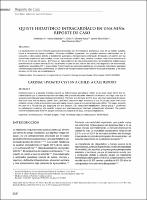Quiste hidatídico intracardiaco en una niña: reporte de caso.
Related Resource(s)
https://rpmesp.ins.gob.pe/index.php/rpmesp/article/view/3258Date
2018Author(s)
Huerta-Obando, Anderson
Olivera-Baca, Erick Y.
Silva-Díaz, Jaime
Salazar-Díaz, Abel
Metadata
Show full item recordAlternate title
Cardiac hydatid cyst in a child: a case report
Abstract
La equinococosis es una infección parasitaria provocada por Echinococcus granulosus, que, en su estado quístico,
forma al denominado quiste hidatídico. Presenta morbilidad importante, con posibles secuelas relacionadas con la
ubicación, y altos costos debido al tratamiento quirúrgico y farmacológico prolongado. El hígado y el pulmón son las
ubicaciones anatómicas más usuales, mucho más raras son el riñón, bazo, cerebro y corazón, este último representa el
0,5 % a 2 % del total de casos. El Perú es un país endémico de esta antropozoonosis y principalmente registra casos
procedentes de la sierra central (95 %). Se presenta el caso de una niña de diez años, con diagnóstico de esta entidad,
clasificación ecográfica CE 1, grupo clínico 1 (confirmado por anatomía patológica) con posterior tratamiento quirúrgico
y farmacológico específico (albendazol). La paciente se recuperó satisfactoriamente de la cirugía practicada, y fue dada
de alta a los 16 días, sin complicaciones. Echinococcosis is a parasitic infection caused by Echinococcus granulosus, which, in its cystic state, forms the socalled hydatid cyst. It presents important morbidity, with possible sequelae related to the location, and high costs due to
surgical and prolonged pharmacological treatment. The liver and the lung are the most common anatomical locations,
and much rarer are the kidney, spleen, brain, and heart, where the latter represents 0.5 to 2% of total cases. Peru is an
endemic country of this anthropozoonosis and mainly records cases in the central highlands (95%). This paper presents
the case of a 10-year-old girl, diagnosed with this disease, CE1 ultrasound classification, clinical group 1 (confirmed
by pathological anatomy) with specific surgical and pharmacological treatment (albendazole) afterward. The patient
recovered satisfactorily from the surgery and was discharged at 16 days, without complications.
Collections
- Artículos científicos [890]






